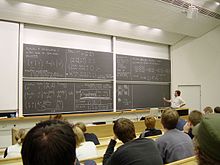- Direct instruction
-
This article discusses direct instruction as a general concept. For DISTAR or Englemann and Becker's Direct Instruction programs, please see those articles.
Direct instruction is a general term for the explicit teaching of a skill-set using lectures or demonstrations of the material, rather than exploratory models such as inquiry-based learning.
This method is often contrasted with tutorials, participatory laboratory classes, discussion, recitation, seminars, workshops, observation, case study, active learning, practica or internships. Usually it involves some explication of the skill or subject matter to be taught and may or may not include an opportunity for student participation or individual practice. Some direct instruction is usually part of other methodologies, such as athletic coaching.
Direct instruction may be ad hoc or even an incidental digression. Although there is usually some element of frontal instruction and a general concept of the skill or lesson, there may or may not be a formal lesson plan.
In some special education programs, direct instruction is used in resource rooms, when teachers assist with homework completion and academic remediation.[1]
Contents
The foundation of DI
Direct instruction was founded by Siegfried Engelmann in 1964 at the University of Illinois Institute for Research on Exceptional Children [2]. However, the direct instruction model is not to be confused with DISTAR, a specific direct instruction model also developed by Siegfried Engelmann and Wesley C. Becker. “Project Follow Through,” the largest educational study ever conducted in America, found that the DISTAR program was proven to be by far, the most effective model in education. Moreover, all direct instruction models that exist are based on Engelmann’s original theories and research regarding the most effective way to teach children.
Success for All
Another popular direct instruction approach is the Success for All program which uses scripted teaching to instruct elementary children in phonics intensive reading instruction program. What the teacher says is carefully scripted in the program. The program was designed by Johns Hopkins University professor Robert Slavin in the mid 1980s for failing inner city schools in Baltimore. The program requires a dedicated 90 minutes of reading instruction each day in which the teacher must follow a pre-ordained lesson plan that has every minute filled with scripted instruction and specific activities designed to teach reading to every child in the class. Chiak Sai~!@#¥%……&*
Discovery learning
This form of instruction is often contrasted with discovery learning (Tuovinen, & Sweller,1999). While many support discovery learning, because they feel students learn better if they "learn by doing," there is little empirical evidence to support this claim, quite the contrary in fact (Tuovinen and Sweller, 1999). Kirschner, Sweller, and Clark (2006) suggest that fifty years of empirical data does not support those using these unguided methods of instruction. Hmelo-Silver, Duncan, and Chinn (2007) [3] argue that Kirschner, et al., are conflating several different models of instruction under the term "discovery learning", and that there is, in fact, empirical data that supports the effectiveness of some of these models.
Opponents of direct instruction believe methods of measuring student progress favor skills that are themselves emphasized by direct instruction and deemphasized by discovery education [4] In addition they suggest aptitude tests focus on students' ability to solve problems, while discovery education emphasizes critical information-seeking and active, fruitful participation in social discourse, goals that cannot be easily measured by traditional empirical methods[citation needed].
References
- ^ Effective direct instruction practices in special education settings. Englert, Carol S. Remedial & Special Education, Vol 5(2), Mar-Apr 1984, 38-47
- ^ (Engelmann, S. (2007). Teaching Needy Kids in our Backward System.Eugene, OR: ADI Press.
- ^ Hmelo-Silver, C. E., Duncan, R.G., & Chinn, C.A. (2007) Scaffolding and Achievement in Problem-Based and Inquiry Learning: A Response to Kirschner, Sweller, and Clark (2006), Educational Psychologist, 42(2), 99–107
- ^ Marchand-Martella, & Martella (2002) An Overview and Research Summary of Peer-Delivered Corrective Reading - The Behavior Analyst Today, 3 (2), 214 -234 [1]
- Kirschner, P. A., Sweller, J., and Clark, R. E. (2006) Why minimal guidance during instruction does not work: an analysis of the failure of constructivist, discovery, problem-based, experiential, and inquiry-based teaching. Educational Psychologist 41 (2) 75-86
- Tuovinen, J. E., & Sweller, J. (1999). "A comparison of cognitive load associated with discovery learning and worked examples". Journal of Educational Psychology 91 (2): 334–341. doi:10.1037/0022-0663.91.2.334.
Standards-based education reform Theorists William Spady • Jean Piaget • Benjamin Bloom • Marc Tucker • Maria Montessori • Constance Kamii • Rheta DeVries • Betty ZanTheories Outcome-based education • Cognitive load • Standards-based education reform • Developmentally Appropriate Practice • Holism • Constructivism • Block scheduling • Holistic grading • Active learning • Problem-based learning • Discovery learning • Inquiry-based learning • Inventive spelling • Open-space school • Small schools movement • InclusionValues Learning standards Standards-based
assessmentAuthentic assessment • Criterion-referenced test • Norm-referenced test • High school graduation examinationStandardized tests Standardized
curriculumDecodable text • Guided reading • Phonics • Whole language • Traditional education • Traditional mathematics • Direct instruction • Rote learning • Grades • Lecture • Tracking (education) • Standard algorithmsExternal links
- Association for Direct Instruction (ADI) homepage
- SRA Website: publisher of direct instruction programs
- Online community and resources for direct instruction teaching
- National Institute for Direct Instruction homepage
- A professional development provider for direct instruction programs
- Educational Resources web site: A Professional Staff Development Company Specializing in Direct Instruction Implementations
Categories:
Wikimedia Foundation. 2010.


